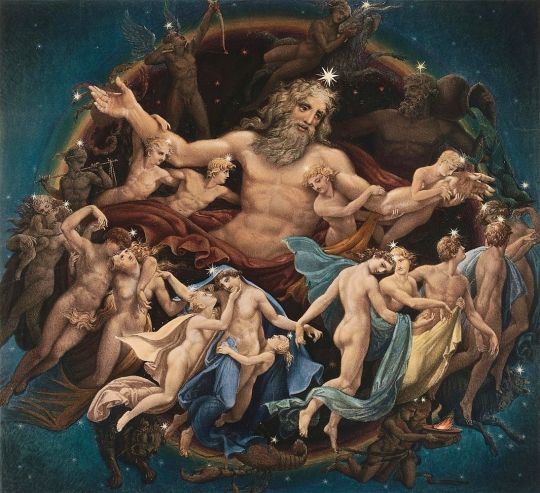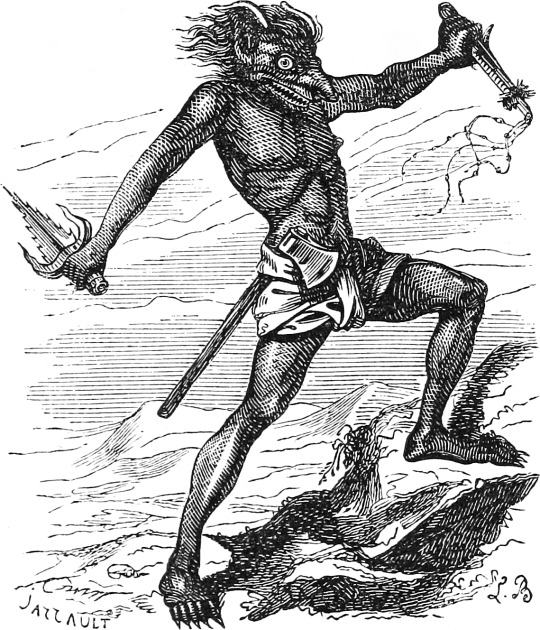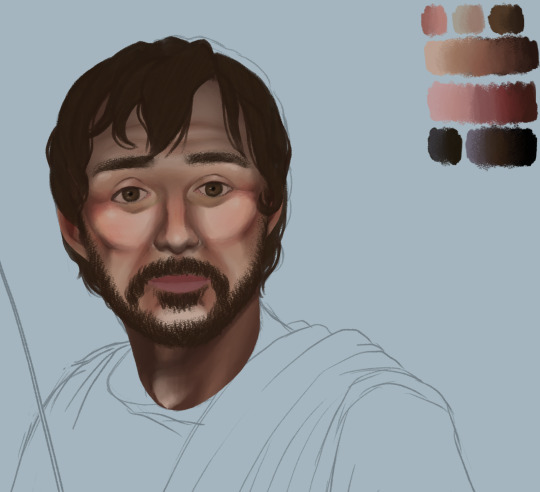#Hesiodo
Text

Inktober Día 24 - Pandora
Y aquella mujer, levantando la tapa de un gran vaso que tenía en sus manos esparció sobre los hombres las miserias horribles. Únicamente la Esperanza quedó en el vaso, detenida en los bordes, y no echó a volar porque Pandora había vuelto a cerrar la tapa por orden de Zeus tempestuoso que amontona las nubes.
#illustration#inktober#inktober2023#ink#black and white#zagan akerman#nicolas garcia barrera#pandora#caja de pandora#pandora's box#hesiodo#hesiod#works and days#trabajos y dias#greek myth#mythology
1 note
·
View note
Text
Comedia, Drama y la Tragedia
En este reporte de investigación, se adentró en la comedia, tragedia y drama; en cuanto a sus características, personajes, temas, audiencia, desenlace y sus objetivos. También se habló de "Los caballeros" y "Antígona".
INTRODUCCIÓN
La comedia, el drama y la tragedia son géneros derivados de la dramaturgia y el teatro; los cuales tuvieron una relevancia importante en la literatura grecolatina. Sin embargo, hay varias cosas que se tienen que analizar a profundidad; todo para la comprensión de un estilo escritura definido, que trajo como consecuencia la creación de historias presentadas a un público, con una…

View On WordPress
#Antígona#Aristófanes#Audiencia#Características#Comedia#Contexto Antropológico#Desenlace#Drama#Dramaturgia#Evolución#Géneros literarios#Hesiodo#Las Once Comedias#Lengua#Literatura#Literatura grecolatina#Literatura Griega#Los caballeros#Objetivo#Personajes#Poesía#Ritual#Teatro#Temas#Tragedia
0 notes
Text
You are a pithos made by God.

#pandora#greek myth#greek myth art#ancient greek mythology#greek mythology#ancient greek myth#Hesiodos#works and days#pithos
243 notes
·
View notes
Text
Yunan Mitolojisi Nasıl Ortaya Çıkmıştır?

Antik Yunan tarihinin en önemli anlatıcılarından birisi de Hesiodos’tur. Heredot, Homeros gibi Hesiodos’un da Yunan inançları ve Yunan tanrılarının yaratılmasından önemli bir rolü olduğuna inanır.
Hesiodos, o dönemde birçok farklı bölge görmüş seyyahların, şairlerin farklı sözlü anlatılarından etkilenerek bir mitolojik bakış açısı geliştirmiş; bunları eserlerinde anlatmıştır. Onun bu bağlamdaki en önemli eseri Theogonia’dır. Theogonia, tanrıların doğuşunu anlatır ve sonraki dönemlerde Yunan mitolojisinde kabul görmüş mitleri temelidir.
Hesiodos, bu eserinde adeta evrenin doğuşunu resmeder. Dünya, Khaos (boşluk) ile başlar der. Ardından Khaos’tan Gaia doğmuştur. Gaia, ana tanrıça bir nevi toprak anadır. Gaia yalnızlıktan kurtulmak için Uranüs’ü (gökyüzünü) yaratır. Sonrasında ise yeryüzü-toprak (Gaia) ve gökyüzünden (Uranüs) diğer tanrılar, titanlar, devler ortaya çıkar. Yani ilk tanrılar doğanın saf temel elementleridir.
33 notes
·
View notes
Text
Me compré un libro nuevo de 6mil pe por 1000, soy feliiiiiiiz
#gracias chica que lo vendió a ese precio simplemente porque le pintó#gracias a mi amiga que me lo fue a buscar porque le quedaba a una estación de tren y a mi a un viaje de más de 2hs#gracias hado por hacerme entrar en el grupo de face de la facu#gracias Hesiodo por tu hermosa obra#graci- *le pegan un tiro*#perdón estoy muy feliz ajajajjaja
6 notes
·
View notes
Text


"The sky winks above, with flawless blue,
Filling our eyes, soothing our souls too.
Celestial winds blow, clouds dance in delight,
The sky is the beginning of a tale, an enchanting flight."
- Hesiod, Theogony
1 note
·
View note
Text
O please, spirit of hesiodos, possess me tomorrow
ὦ μοῦσαι καἰ δαῖμον Ἡσῐόδου – εὐθῦνετε με νῦν
#is it right to call hesiodos a δαιμον#δαιμων*#im sure he’ll appreciate it#i swear i wont act like the σιδηρεον γενος#or the χαλκειον γενος
0 notes
Note
Hello Nox
How are you? I hope you're fine
Could you talk about Peitho 118? if you haven't made any posts related to this. I think she named after one of Aphrodite's companion Peitho? So, I'm curious about this goddess and her role in astrology too
Thank you, have a nice day 💜💜
peitho, goddess of persuasion (asteroid 118)

The origin of Peitho is rather unclear in the classics - she doesn't originate from Homer or Ovid. Hesiod only briefly mentions her. It was Sappho who gave her a bit of definition and shape. Sappho stated that Peitho was an attendant of Aphrodite; she held the secret to divine love and thusly knew how to persuade and seduce someone. Some say that she was the one who married the tragic lovers Cadmus and Harmonia... Frequently, she is depicted in art at the weddings of significant lovers like Dionysus and Ariadne, Thetis and Peleus, Aphrodite and Adonis, etc. Infamously, Peitho was at the abduction of Helen by Paris because her divine magic was needed for Paris to convince Helen to leave with him per the promise of Aphrodite. IN MY OPINION Peitho in your chart can indicate a) where your origin is unclear, b) where you facilitate romances for others, c) where you convince couples to stay together, and/or d) your abilities to romantically persuade others and seduce them.

i encourage you to look into the aspects of peitho along with the sign, degree, and house placement. for the more advanced astrologers, take a look at the persona chart of peitho AND/OR add the other characters involved to see how they support or impede peitho!
OTHER RELATED ASTEROIDS: homerus (5700), hesiodos (8550), ovidius (2800), cadmus (7092), sappho (80), aphrodite (1388), harmonia (40), ariadne (43), dionysus (3671), adonis (2101), helene (101), and paris (3317)!
like what you read? leave a tip and state what post it is for! please use my “suggest a post topic” button if you want to see a specific post or mythical asteroid next!
click here for the masterlist
click here for more greek myths & legends
want a personal reading? click here to check out my reading options and prices!
#astrology#astro community#astro placements#astro chart#asteroid astrology#asteroid#natal chart#persona chart#astrology tumblr#greek mythology#cafe astrology#astrology chart#natal astrology#astrology readings#astro notes#astro observations#peitho#asteroid118#ovidius#asteroid2800#cadmus#asteroid7092#sappho#asteroid80#aphrodite#asteroid1388#harmonia#asteroid40#ariadne#asteroid43
71 notes
·
View notes
Text


Ever so slowly I make my way through designing the Pantheon, this time - Trios!
The Magic Trio - Zeka (she/they), Hesiodos (she/he), and Swabbel (she/her)
The Three Dreams - Kingsley (she/her), Hellena (they/them), and Nightshade (he/him)
#art#digital art#creati pantheon drawings#the magic trio is also known as 'the little girl club' because honestly that's just what they are
7 notes
·
View notes
Text
Hades and his aid to heroes in greek myths
Out of all the gods in the greek pantheon, Haides has the strongest reputation for being closed off and uninvolved with humans. After all, he lives in the underworld and rarely, if ever, leaves his realm.
However, after thinking about greek mythology obsessively (as I always do), I realized that there is a pattern of Hades helping heroes/mortals. He doesn’t help them directly like Athena or Hermes do because he’s always in the underworld, but he does aid mortals even when there’s no obligation for him to do so. Here are some examples:
Hades lending his helmet of invisibility to Perseus so he can slay the gorgon
Pseudo-Apollodorus, Bibliotheca 2. 36 - 42 (trans. Aldrich) (Greek mythographer C2nd A.D.) :
“These Nymphai had in their possession winged sandals and the kibisis, which they say was a knapsack.--Pindaros and Hesiodos in the Shield of Herakles, describe Perseus as follows : ‘The head of a terrible monster, Gorgo, covered all his back, and a kibisis held it.’ It is called a kibisis because clothing and food are placed in it.--They also had the helmet of Haides. […] Perseus then placed the head in the kibisis and headed back again, as the Gorgones pursued him through the air. But the helmet kept him hidden, and made it impossible for them to identify him.”
Hades giving his hound to Heracles so he can fulfill his labors and letting him free his prisoners
Pseudo-Apollodorus, Bibliotheca 2. 125 (trans. Aldrich) (Greek mythographer C2nd A.D.) :
“Herakles asked Plouton (Pluton) [Haides] for Kerberos (Cerberus), and was told to take the hound if he could overpower it without using any of the weapons he had brought with him."”
Pseudo-Hyginus, Fabulae 79 (trans. Grant) (Roman mythographer C2nd A.D.) :
“When Hercules came to lead out the three-headed dog, they [Peirithoos and Theseus, trapped in the underworld] begged his promise of protection. He obtained the favor from Pluto [Haides], and brought them out unharmed.”
Hades and Persephone allowing Orpheus to leave the underworld with his deceased wife
Pseudo-Apollodorus, Bibliotheca 1. 14 (trans. Aldrich) (Greek mythographer C2nd A.D.) :
“When his [Orpheus'] wife Eurydike (Eurydice) died from a snake-bite, Orpheus descended into Haides' realm with the desire to bring her back up to earth, and persuade Plouton (Pluton) [Hades] to release her. Plouton promised to do this if on the return trip Orpheus would not turn round before reaching his own home. But he disobeyed, and turned to look at his wife, who thereupon went back down again.”
Ovid, Metamorphoses 10. 8 ff (trans. Melville) (Roman epic C1st B.C. to C1st A.D.) :
“[…] the queen [Persephone] and he whose sceptre rules the underworld could not deny the prayer, and called Eurydice.”
Hades and Persephone granting Odysseus’ wish
Homer, Odyssey 10. 135 ff (trans. Shewring) (Greek epic C8th B.C.) :
“Then I called to my comrades and bade them flay and burn the sheep that lay there slain with the pitiless bronze, and to make prayer to the gods, to mighty Hades and dread Persephone.” (Immediately after this, Hades and Persephone answer Odysseus’ prayer)
Bonus: Hades lends Hermes his helm of invisibility so he can protect himself while battling the giants
Pseudo-Apollodorus, Bibliotheca 1. 34 - 38 (trans. Aldrich) (Greek mythographer C2nd A.D.) :
“Hermes, who was wearing the helmet of Haides, killed Hippolytos in the course of the battle, and Artemis killed Aigaion (Aegaeon).”
My thoughts
So if Hades answers prayers, lets other gods and mortals borrow his most valuable weapon, and even breaks his own rules (no one can leave the underworld) to grant other people’s wishes, how can we call him closed off? From this pattern of behavior, it seems like he’s extremely caring and generous . We have to kill the myth that chthonic deities are unresponsive and apathetic.
Here’s an article about Hades’ worship for everyone who wants to keep reading about this topic
88 notes
·
View notes
Photo

The Alastor [Greek mythology; Christian demonology]
In Greek mythology, the name ‘Alastor’ refers to several individuals, including Zeus. It also the name of a specific group of malicious spirits or demons. In particular, an Alastor is an avenging spirit and is associated with a specific family, punishing the members of that bloodline for crimes and misdeeds. These punishments are dissed out on behalf of the Alastor’s host and were said to be the avengers of the dead.
When the Persians invaded Greece, the slave Sicinnus deceived Xerxes, making him send his troops right into an enemy ambush. Poets later claimed that Sicinnus was told to do so by an Alastor, implying that these spirits manipulate people into making decisions that end in bloodshed.
Note that the word ‘demon’ carries a distinctly negative connotation in English, but this wasn’t necessarily the case in ancient Greece: the word daimon (plural daimones), according to Hesiodos in the 8th century B.C., referred to the undead spirits of the people who lived in the mythical ‘golden age’. After dying, these people would return to the world of the living as invisible spirits. They were benevolent, distributing wealth to the living, as long as they were respected. But malicious demons also existed and in some cases, demons were associated with a particular individual and punished them for bad deeds. Or in the case of Alastor demons, with an entire family.
The name ‘Alastor’ was later carried over to Christian demonology as a specific demon: in this iteration, the devil Alastor delivers the sins of fathers onto their children. He also tempts mortals into committing murders. According to Jacques de Plancy’s 1818 Dictionnaire Infernal (see image), Alastor is the executor of decrees in Lucifer’s court of justice. Even among the demons of hell, he is said to be exceptionally cruel and severe.
Sources:
Hastings, J. E., 1911, Encyclopaedia of Religion and Ethics, Volume IV, p.591, which you can read here.
Saniotis, A., 2004, Tales of Mastery: Spirit Familiar in Sufi’s Religious Imagination, Ethos, 32(3): pp 397-411.
De Plancy, J. C., 1818, Dictionnaire Infernal ou Recherches et Anecdotes sur les Démons, les Esprits, les Fantômes, etc., Paris, France.
Bane, T., 2014, Encyclopedia of Demons in World Religions and Cultures, McFarland, 416 pp.
Jones, L., 2005, Encyclopedia of Religion, Volume 4, Macmillan Reference USA, USA, 112 pp.
(image source: Louis le Breton, illustration for 1863 edition of ‘Dictionnaire Infernal’)
94 notes
·
View notes
Text

ANCIENT GREECE AU??? MORE LIKELY THAN YOU THINK!!
as much as i love patrochilles being reincarnated as solangelo or ruegard, i want more gays reincarnating and continuing to be gays. so here are hesiodos and adrastus (not the actual poet and figure from mythology) aka leeluke of the trojan war!
#lee fletcher#luke castellan#lee fletcher x luke castellan#pjo#pjo au#percy jackson and the olympians#rizart
14 notes
·
View notes
Text
Digital Sketchbook (06.20.2024)



I'm about to make a big update post for my main website, but I didn't feel like using up storage on some preview shots. At the top, we've got progress on my 2d model for my YouTube channel, along with the many outfits I've made for her. Once I'm done with all the shading, I can break down the pieces and start the rigging process. I've probably got more outfits than I need, and there are some side characters I may make that I've had bouncing around in my head and on my channel for a long time that I'll probably also make, but once the bulk of it is done, I can focus on rigging while that happens.
On the bottom left, we've got a new Hesiodos (Hesiod) piece I'm working on. I wasn't happy with how the first one turned out, and honestly, I need to get back into the flow of more realistic works. Painting pieces directly from photo reference is easy enough, but it's a bit more difficult using a marble statue, as I did with my first piece, and more difficult still drawing from the mind while trying to translate those references as accurately as possible. I'm also using a more gouache-inspired brush set for this one. I've been super fascinated with acrylic gouache lately and am planning to start doing traditional pieces again in marker, watercolor, and acrylic gouache. I've been really into the work of Amina Illustration and I'm A Wonder.
My YCH (Your Character Here) commission piece "Little Witch" still has 5 available slots left on my Etsy shop (which is discounted from what you would pay for a custom commission with those specifications) - but I had also started on a number of other ones back in autumn of last year: A little graveyard chibi pin-up, a chibi girl holding a pumpkin spice latte, a woman kissing the cheek of a scarecrow, and a vampiric take on Klimt's The Kiss. I also started on a few general ones: one inspired by the style of Bratz, one inspired by the style of Monster High, and one inspired by the lo-fi girl. I'll still be wrapping them up and making them available whenever they're complete, but they aren't at the forefront of my workload at the moment - especially since I'm planning on moving away from Etsy.
Along that line, I also have plans to work on a couple of emote, clip art, and marketing packs, some stickers (including sticker sheets for my planners), a magickally-accurate Sailor Moon chibi series, and a couple of fan oracle decks. First on my to-do list, however, is a ton of website graphics for my new websites, the next batch of designs and styles for the Luxe Gothique Boutique, and a rework of my Khthonic Wiccan art series, as it's something else I just wasn't satisfied with.
And that's just artwork! I have a lot of writing in the works now, as well. I've got two books, my Mythos Reimagined series, and my webcomic, A Little Town Called Lorauvial, in the works, as well. This is a lot, I know, but I'm making progress each day. I just want to make so many things. I can't possibly keep it all locked away forever. 👻💚
Anyway, stay tuned for my update article. I'm going to be getting on that shortly with info on my other goings-on. Be there or be square.

4 notes
·
View notes
Text
Hesiodos der ki:
Çömlekci
Çömlekçinin,
Şair
Şairin,
Dilenci
Dilencinin düşmanıdır.
~♡ Platon (Eflatun) - Lysis Lakhes

22 notes
·
View notes
Text
El Titán caníbal

#HallowdRPintura01 + #AllanPoe
☪︎ Francisco de Goya - Saturno devorando a su hijo
ㅤㅤㅤㅤㅤㅤㅤㅤ
ㅤㅤㅤ.•⋆:。. «Los dioses tramaron desventuras para que los hombres y las generaciones venideras tuviesen sobre qué cantar.»
ㅤㅤㅤㅤㅤ -Homero.
ㅤㅤㅤㅤㅤㅤㅤ
Imprudentemente, el titán bebió el vino oscuro y su sonrisa se deshizo. Y temblando con la violencia que Océano rompe sus olas, él vomitó la piedra de Ónfalos. Fue escupida con tanta velocidad que atravesó a Urano como una daga: voló a través de la mitad del mundo, cayó con precisión en el medio; pasó por la tierra de los muertos y el oscuro Tártaro, ¡y Ónfalos partió por la mitad al ombligo del mundo y llegó hasta el gran abismo!
Y Cronos, enloquecido por Némesis y las tres Furias, volvió a beber vino. Temblando nuevamente, escupió a dos de sus hijos mayores; Poseidón y Hades. Ambos volaron a través del cielo y cayeron: Hades aterrizó en la tierra de los muertos y Poseidón, en el reino del océano.
Entonces Cronos vomitó otra vez, acabando de beber los restos de aquella copa. Sus entrañas se estremecieron y sangró, escupió entonces a sus devoradas hijas, se derrumbó en la inconsciencia y las Erinias mutilaron sus brazos y su cabeza partieron, los pájaros oscuros dieron vueltas alrededor de él; y las tres Furias siguieron a Némesis, abandonando el palacio.
Y por eso nadie vio la caída de las hijas de Cronos: De Deméter; mientras aterrizó entre claros y anchos campos de trigo. De Hestia; en el centro ardiente del palacio. De Hera; directamente en los brazos de Zeus.
El todopoderoso hijo de Cronos tomó a Hera con fuerza y, debido a ese peso inesperado, estampó su pie: en todo el mundo se escuchó ese estruendo, llegó incluso al inframundo. Los poderosos hecatónquiros fueron despertados por el gran trueno, sus manos se elevaron —tan numerosas como ríos—, ¡y se abrieron paso desde el Tártaro horadado por el Ónfalos! Salieron a la luz y tras ellos llegaron sus hermanos los Cíclopes —los herreros del mundo subterráneo—, y les trajeron regalos a sus sobrinos.
Al hijo mayor; Hades, le llegó el yelmo de la invisibilidad: quien lo porta es invisible para los dioses, las personas y los monstruos. Al hijo mediano; Poseidón, vino el tridente frío, con el que el mar hervirá con tormentas o mandará a la calma caer sobre él. Pero al hijo menor, a Zeus, hijo de Cronos, le llegó el cetro real, el rayo ensordecedor, intolerable para todos en los mundos terrestres y celestiales. Sólo los cíclopes subterráneos y los poderosos hecatónquiros, Nyx y Erebus no le temen.
Y Zeus entonces agitó el rayo y Cronos cayó de su palacio en la montaña. Una vez más se levantaron las manos de los hecatónquiros, agarraron a sus hermanos los titanes, se los llevaron al Tártaro, hasta el final de los tiempos, cantando en sus oídos:
—Lo que cosechas es lo que siembras.
Luego, Némesis voló tres veces, disfrazada de gorrión alrededor de Zeus y Hera. A sus pies, entonces creció un árbol de cobre con hojas plateadas y manzanas doradas, ya sea que Gea lo cultivó, o si los Cíclopes lo habían hecho una vez más. Zeus, el héroe, aceptó este árbol milagroso como suyo y de Hera.
Al fin derrotaron a su padre Cronos, al Titán Caníbal; y su momento de gloria había comenzado.
//Hice este poema épico para un proyecto narrativo el 10 de noviembre del 2022.
//Quise describir lo que representaba conceptualmente la pintura, el emblema alegórico de Cronos devorando a sus hijos recién nacidos por temor a ser destronado por alguno de ellos (Saturno, en la mitología romana). Una breve prosa épica basada en la antigua obra poética de Hesiodo, La Teogonía. Y sobre todo narrar el final trágico de Cronos, dejando el legado de Zeus después de la Titanomaquia.
//Espero que te guste, mi rey. 🩷
5 notes
·
View notes
Text
En 15 minutos arranco un curso, les presento mi humilde escritorio

#mi acompañante es el matafuegos#entre el tránsito y que salí 17:30 de la facu porque me quedé hablando con mi amiga no hay chance que la primera hora sea desde acá 🤣#anyways Homero y Hesiodo los amo💚
5 notes
·
View notes